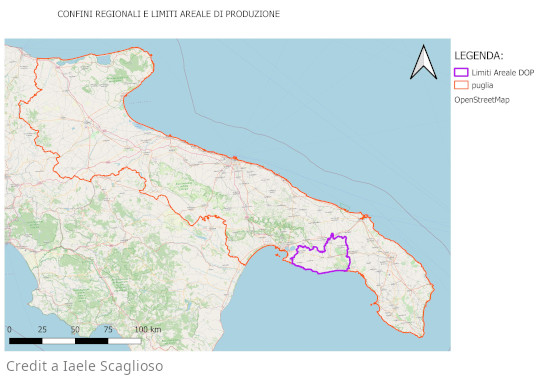Primitivo di Manduria DOC, denomination of origin and production areas
The Primitivo grape variety, apart from its American and Balkan cousins, is also cultivated in other parts of Italy, such as in neighbouring Campania and Basilicata, where it is also present in appellations of origin such as Falerno del Massico DOC and Primitivo di Matera DOC, both of which are more recently established than Manduria DOC.
Let us not forget that in Puglia, Primitivo also has an important recognition in the Gioia del Colle DOC, established in the late 1980s precisely to mark another vocated territory, precisely the land of the vine in our peninsula. It is most interesting to note how this denomination, too, is collecting around itself extremely important productions, with certainly different facets from its Salento brethren, but with a specificity that is being defined and evolving over the years. In this article, however, we focus on Primitivo di Manduria DOC and the specificities that characterise it.
Importance of the Primitivo di Manduria DOC denomination
Primitivo di Manduria DOC is nevertheless the best known and most widespread Primitivo-based denomination in Italy and abroad. Regulated and protected by a special Consortium of Protection, it took its name from the town from whose railway station, in the past, tankers of blended wine left for Northern Italy and Europe.
Compared to that of other areas, Primitivo di Manduria tends to express greater strength, richness, character and complexity of aromas, particularly when the grapes come from old alberello. The terroir is ideal for the growth of these precious little plants: the climate is in fact characterised by high average annual temperatures, dry summers and good temperature ranges; the soil is generally “red earth”, as it is rich in iron oxides, shallow and on a calcareous substratum; sea breezes blow all year round between the vineyards, keeping the environment dry and ventilated and thus guaranteeing the health of the grapes.
Specificity of the designation area
Currently, the DOC area includes no less than 18 municipalities located east of the city of Taranto, along the Ionian coast on one side and bordering the province of Brindisi on the other, a province whose DOC area includes a few municipalities.
The region, although very circumscribed, presents considerable diversity in terms of terroir, to the point of delineating a zoning that takes into account the specificities of the territories. They range from the hills of northern Taranto to the coastal dunes of upper Salento, where saplings live side by side with Mediterranean shrubs such as thyme, lentisk and rosemary.
The area around the town of Sava is very important, as it is rich in vineyards still cultivated using the alberello system on red soil, which in some cases form true crus.
Primitivo di Manduria and San Marzano Wines
In addition to the aforementioned Sessantanni, Anniversario 62 and 11 Filari, there are many San Marzano labels that tell of the privileged relationship we have with this grape variety that is so identifiable to our territory. The product specification states that the Primitivo di Manduria DOC denomination includes several types. Of these, the dry version has a minimum alcohol content of 13.5%, the highest minimum alcohol requirement for an unfortified dry wine denomination in the world. In the dry version San Marzano offers Talò Primitivo di Manduria DOP, a full-bodied red with elegant tannins.


Bibliography and sitography: Primitivo di Puglia by Giuseppe Baldassarre (INPUT editions); Dal ‘Merum’ al Primitivo di Manduria by Gianni Iacovelli, Bianca Tragni, Pietro Gargano (Filo Editore); La Stirpe del Vino by Attilio Scienza and Serena Imazio (Sperling & Kupfer); www.quattrocalici.it .
